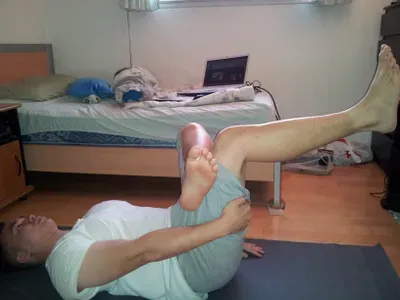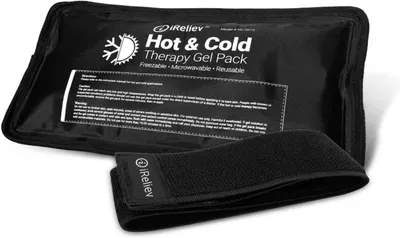From Sciatica Stretches: The Best Sciatic Nerve Pain Relief
If you're looking for sciatic nerve pain relief, you're not alone. Sciatic nerve pain affects millions of people around the world.
But the good news is that some simple and effective sciatica stretches can help. In this article, we'll share the best sciatica stretches for pain relief.
What Is Sciatica?
Sciatica is a condition that can cause pain in your lower back and legs.
Sciatica can be caused by a variety of things. Including herniated discs, spinal stenosis, and pregnancy.
Treatment for sciatica often includes sciatica pain relief medication, physical therapy, and exercises.
Sciatica Symptoms
Sciatica symptoms can differ depending on where the sciatic nerve is compressed.
Yet, the most common symptom is pain that radiates from the low back down the leg. Other symptoms may include tingling, numbness, or weakness in the leg.
Sciatica is typically caused by a herniated disc, bone spur, or narrowing of the spinal canal.
If you think you may have sciatica, it's important to see a doctor. So they can diagnose the cause of your pain and recommend treatment options.
What Causes Sciatica?
The sciatic nerve is the longest nerve in the body, running from the lower back all the way down the leg.
Sciatica is a condition that occurs when this nerve becomes compressed or irritated, resulting in pain that radiates along the length of the nerve.
There are many possible causes of sciatica, including herniated discs, degenerative disc disease, spinal stenosis, and pregnancy.
What Is The Sciatic Nerve?
The sciatic nerve is the longest nerve in the human body, running from the lower back all the way down to the feet.
When Your Sciatica Warrants A Visit To Your Doctor
When your sciatica pain becomes severe, it may warrant a visit to your doctor. Your doctor can help determine the cause of your pain and recommend the appropriate treatment.
If your pain is caused by a herniated disc, for example, your doctor may recommend conservative treatment options such as physical therapy or epidural injections.
If your pain is severe and does not respond to conservative treatment, surgery may be necessary.
What Causes Sciatic Nerve Pain?
Sciatic nerve pain can be caused by many things, including herniated disk, spinal stenosis, and degenerative disk disease.
These conditions can all lead to the sciatic nerve becoming compressed, which can then cause pain.
In some cases, pregnancy can also cause sciatic nerve pain, as the growing uterus can put pressure on the nerve.
What Are The Best Exercises For Sciatica?
The best exercises for sciatica may vary depending on the individual. However, some suggested exercises that may help relieve pain associated with sciatica.
Include gentle stretching, for the hamstrings and lower back. Strengthening exercises for the core muscles, and aerobic exercise to increase blood flow and reduce inflammation Yoga poses, and Pilates exercises.
It is important to consult with a healthcare professional before beginning any new exercise regimen, as certain exercises may aggravate symptoms.
Sitting Spinal Stretch
The spinal sitting stretch is a great way to improve your flexibility and reduce back pain. This stretch helps to lengthen the spine, which can help to reduce pressure on the discs and nerves in the back.
To do this stretch, sit on the floor with your legs extended in front of you. Reach your arms overhead and interlace your fingers.
Then, gently pull your head down towards your chest, rounding your back as you do so. Hold this position for a few deep breaths before releasing and repeating on the other side.
Hamstring Stretches
Hamstring stretches are important for maintaining flexibility in the lower extremities. The hamstrings are a group of three muscles that run along the back of the thigh, from the hip to the knee. These muscles are responsible for extending the hip and flexing the knee.
Static stretches, like the ones typically used to stretch the hamstrings, are best performed after a workout when your muscles are warm and pliable.
Hip Abductor Stretches
The hip abductor muscles are a group of muscles located on the outside of the hip. These muscles work to move the leg out to the side (away from the body).
There are a few different ways to stretch the hip abductor muscles. One way is to stand with your feet about shoulder-width apart and your hands on your hips.
From here, you will want to slowly step one leg out to the side and lean your body weight over into that leg.
Gluteal Stretches
The gluteal stretch is a common sciatica stretch that targets the muscles of the buttocks.
The exercise is performed by lying on your back with your knees bent and your feet flat on the ground.
Then, you raise one leg and place your ankle on the opposite knee. Next, you gently pull the raised leg towards your chest until you feel a stretch in the muscles of the buttocks. This stretch can also be performed with both legs simultaneously.
Piriformis Syndrome Stretches
Piriformis Syndrome is a condition in which the piriformis muscle, a small muscle located deep in the buttock, becomes tight and irritates the sciatic nerve.
The symptoms of Piriformis Syndrome include pain in the buttock and down the leg, numbness, and tingling in the leg, and weakness in the leg.
The condition is treated with stretching exercises, massage, physical therapy, and sometimes injections of corticosteroids.
Lifestyle And Home Remedies
There are some lifestyle and home remedies that can help relieve the pain and discomfort associated with sciatic nerve pain. One of the best things you can do is to maintain good posture and alignment.
This means sitting, standing, and moving in ways that put minimal stress on your spine and nerves.
In addition, staying active and exercising regularly can help to improve your overall strength and flexibility, which can help to prevent sciatica flare-ups.
Some specific exercises that may be helpful include yoga, Pilates, and swimming.
If you are experiencing sciatic nerve pain, it is also important to get plenty of rest and avoid activities that aggravate your symptoms.
Ice or heat therapy may also help ieve over-the-counter anti-inflammatory medications such as ibuprofen or naproxen can also be effective in managing pain.
Best Solutions For Sciatic Nerve Pain Relief
There are many solutions for sciatic nerve pain relief. Some people find relief with stretches and exercises, while others find that massage is the best solution. For people who have chronic pain, acupuncture may be an option.
For people who suffer from occasional sciatic nerve pain, stretches and exercises may be all that is needed to find relief.
The best way to stretch the sciatic nerve is to lie on your back with your knees bent and your feet flat on the floor.
Slowly bring your right knee up to your chest and hold it for 30 seconds. Repeat this stretch with your left leg.
You can also do this stretch while sitting in a chair by crossing one leg over the other and leaning forward until you feel a stretch in your buttocks.
If you have chronic pain, you may need to try several different solutions before you find one that works for you.
Ice And Heat Therapies
There are two main types of sciatic nerve pain relief therapies: heat and cold.
Heat therapy dilates blood vessels and increases blood flow to the area, which helps reduce inflammation. Cold therapy numbs the area and reduces muscle spasms.
Both heat and cold therapies can be effective in relieving sciatic nerve pain. It is important to experiment with both to see which provides the most relief.
Stretching And Physical Therapy
If you're dealing with sciatic nerve pain, you're not alone. Sciatica is one of the most common forms of nerve pain, affecting up to 40% of adults at some point in their lives.
The good news is that there are some things you can do to relieve your sciatica pain, including stretching and physical therapy.
Stretching is a great way to ease sciatic nerve pain. A simple stretching routine can help to loosen the muscles and tissues around the sciatic nerve, providing relief from pain and discomfort.
Physical therapy can also help treat sciatica. A physical therapist can teach you specific exercises and stretches that can help to relieve your symptoms.
Best Sciatic Nerve Pain Medication
There are several different medications that can be effective in treating sciatic nerve pain. Over-the-counter options like ibuprofen and acetaminophen can help to reduce inflammation and pain.
Prescription medications such as muscle relaxants and anti-inflammatories can also be helpful.
In some cases, steroid injections may be recommended to help reduce the inflammation around the sciatic nerve.
Conclusion
The best sciatic nerve pain relief. Is achieved through a combination of exercises and stretches.
These exercises and stretches should be performed regularly. To maintain good sciatic nerve health.
With regular care, the pain associated with sciatica can be reduced. Or even eliminated.
Try Sciatica Pain Relief Stretches For Legs And Hips
People Also Asked
What is good for sciatic nerve pain?
There are some things that can help with sciatic nerve pain.
First, it is important to keep the area around the sciatic nerve clean and free from irritants.
Second, gentle stretching exercises can help to relieve tension in the area and provide some relief from pain.
Finally, over-the-counter pain medications can also help manage sciatic nerve pain.
What helps relieve sciatica nerve pain?
If you are experiencing sciatic nerve pain, there are a few things you can do to help relieve the pain. First, try to avoid any activities that aggravate the pain.
If sitting or standing for long periods makes the pain worse, try to take frequent breaks to move around and stretch.
You can also try placing a heating pad or ice pack on the affected area for 20-30 minutes at a time to help relax the muscles and ease the pain.
What takes sciatica pain away?
The best way to treat sciatica pain depends on the underlying cause of the condition.
However, some common treatments that may help relieve sciatica pain include stretching and strengthening exercises.
Massage therapy, heat and cold therapy, and pain medications. In severe cases, surgery may be necessary to relieve pressure on the nerve root.
How to ease pain from a sciatic nerve?
The sciatic nerve is the largest in the body and is responsible for transmitting signals from the brain to the muscles of the lower leg.
When this nerve becomes compressed or irritated, it can cause pain that radiates from the back and down the leg.
There are many ways to ease pain from a sciatic nerve, including:
- Rest: Taking a break from activities that aggravate the sciatic nerve can help to ease pain and inflammation. Ice can be used to help reduce swelling, and gentle stretching exercises may assist in muscle recovery.
- Anti-inflammatory Drugs Nonsteroidal anti-inflammatory drugs (NSAIDs) such as ibuprofen and aspirin can be used to ease the pain.
the - Heat Use a warm water bottle or heating pad to help relieve pain and inflammation.
- Muscle Relaxants such as cyclobenzaprine and methocarbamol can help to reduce muscle spasms and ease the pain.
- Physical therapy can help to improve muscle strength and flexibility and assist in the recovery process.
- Corticosteroids Injections of corticosteroids into the affected area may help to reduce inflammation and pain.
Does sciatic nerve pain get better
Whether or not sciatic nerve pain gets better is largely dependent on the root cause of the problem.
For instance, if a herniated disk is putting pressure on the sciatic nerve, then performing exercises and stretches that target that specific area may help to ease the pain.
However, if the pain is caused by something more serious, such as a tumor, then it is unlikely that it will get better without treatment.
That said, some general things can be done to help ease sciatic nerve pain. For example, over-the-counter pain medication can help to take the edge off.
Additionally, applying heat or ice to the affected area can also provide some relief. Finally, practicing good posture and avoiding activities that worsen the pain can also help manage sciatic nerve pain.




